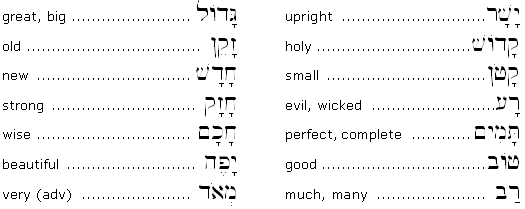|
Hebrew Adjective Inflectional Patterns
Since adjectives must agree with the noun they modify in gender and number, every adjective can take four possible forms: two for masculine nouns (singular and plural), and two for feminine nouns (singular and plural). These forms are changed by means of adding endings to the stem of the word, much in the same manner as endings are attached to nouns.
Basic Adjective Endings
The table below shows the most common adjective endings (called inflectional endings):

These endings are identical to the regular noun endings you studied.
For example, here are the inflections for the adjective tov:

Notice how the endings (indicated in red) are appended to the stem of the word to form the various gender and number properties of the adjective.
Noun - Adjective Agreement
Adjectives must agree with the nouns they modify in gender and number. For example, consider the following adjective phrases:

Notice that the adjective tov is inflected to match the gender and number of the noun it is modifying. Note further that the gender of an adjective does not change its meaning, only its form. Finally note that adjectives that are plural in form are singular in translation (for example good sons; the word good in Hebrew would appear in the plural form (tovim) but would be translated using a singular term, good).
The agreement between a noun and an adjective must occur, even if the noun uses irregular endings. For example,

Patterns of Inflection
Generally, adjectives are inflected in the same way as nouns, with vowel changes that occur based on the types of consonants that comprise the root of the word.
Case 1: No Vowel Change
This class of adjective does not produce any sort of change apart from the addition of the plural endings. Often these nouns are monosyllabic or have an unchangeably long vowel in the first syllable.

Case 2: Propretonic Reduction
Many adjectives that have a Qamets or Tsere vowel as their first syllable undergo "propretonic reduction" when the plural endings are added to the word:


Note that this adjective has an unchangeably long vowel (Cholem Vav) in the second syllable.

Notice that adjectives with an initial guttural consonant cannot take vocal sheva, but are reduced to a chateph form.
Case 3: Adjectives that end in Hey
For adjectives whose roots end in Hey, when the endings are added to the root, the Hey drops off from the word:

When you see a plural such as yaphim, you need to remember that it might come from an adjective that has dropped its final Hey in the root.
Case 4: Geminate Adjectives
A "geminate" adjective has a hidden twin letter that does not appear in the masculine singular form. The hidden letter reappears in the plural form with a strong dagesh mark:

In the example above, the root actually is Resh, Bet, and Bet, but the doubled Bet does not show up in the masculine singular.
Finally, there can be vowel changes for some geminate adjectives that have guttural letters:

In the example above, the Ayin cannot accept a dagesh, and the Patach vowel "compensates" by lengthening to a Qamets.
Section Exercises
- Memorize the section vocabulary (top of the page)
- Write out the inflections for each adjective given in the vocabulary
- Summarize the rules of inflection on a small flashcard
<< Return
|



